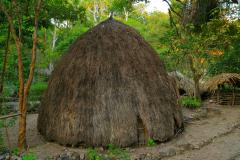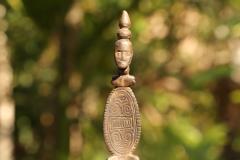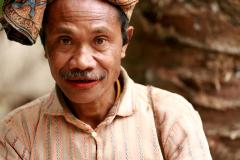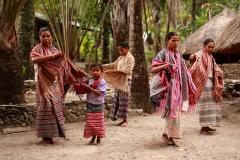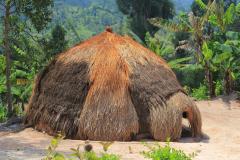Meeting King of Boti
Soe, Andy a guide and a policeman, traditional village Boti and few more problems with a car
Timor. I can't even describe how much I love places likes this: English is completely useless, nothing to really see, tropical laziness in the air and me being main attraction in the town for everybody because tourists seldom come here.
"Mister, mister! Bule (white man), bule! Foto, foto! Tenk you tenk you!"
My heart rejoices here.
Yesterday I calculated that if I sell my apartment in Bratislava I can buy approximately 45 houses here :-)
Soe is not any sort of tourist/traveling destination on its own, but I came there because around Soe, there’s couple of traditional villages, which are supposed to be the highlight of a trip to Timor. According to the bible (read Lonely Planet) Boti should be as traditional as it gets in 21st century: the village is still ruled by a king, kids only attend primary school (high school is forbidden by the king), local villagers are still animists and live their daily lives in the same way as hundreds years ago and refuse any assistance from Indonesian government, making Boti an island of yesteryears, or yestercenturies, I may say. This village is no hidden, that Dutch colonists never found it and neither the head hunters (head hunting was stil popular sport in these areas just few decades ago) and so Boti villagers could without any interruption mind their own business since they settled here. And while now the village welcomes tourists, not too many people make it here, since Timor itself is rarely visited and to get to this isolated villages is bit of pain. The bible also mentioned that the king prohibits individual visits and one must come with a guide who speaks their tribe language. So while I always avoid any sort of organized trips and guides this time I had no choice, but to find a guide. I wanted to find one in a tourist office in Soe (quite surprising that they had one), but first of all I almost didn’t find it, because no one seemed to know where it is and when I finally found it, it was closed. But just outside the office there was a guy on a scooter who spoke to me in English (first words in English in Soe for me) and told me he was a guide. Struck with Asian-touts-paranoia I was bit reluctant to trust him in the first moment, but then he said that apart from being a guide his real job is policemen and was ready to show me his ID. Few sentences later, I agreed to go to Boti with him the next day, and paid a hefty amount of money for that, because to get there you need a jeep which we had to hire, as the only usable road there is actually no road at all. Then he invited me to his home. He called it “police ashram” and it was a house run by the police for its employees so it was shared by couple of policemen. His name was Andy, I met his wife Lin, who could also speak English (actually she was an English teacher) and his beautiful daughter Chelsea, and spend some nice time with them, over cookies and tea.
In the morning Andy picked me up with in my hotel with a huge Toyota jeep and we set off to Boti. Unfortunately, the car that Andy got was not really optimal, because while it was a big fat jeep, it was not 4WD, and even worse, it was back-wheel drive car, so basically the worst thing you can get for off-road. It took several hours to get to the village, although it was only some 50km away, we ruined one tyre (luckily it didn’t get flat until we arrived to Boti), had to cross a small river, but after back-killing ride we got to Boti. The village is just as Lonely Planet describes it. While far from being “undiscovered”, obviously nothing that is mentioned in Lonely Planet can be undiscovered, the village was extremely peaceful and beautiful. No electricity, no running water, all the houses were made from traditional materials without usage of single nail, except for the king’s house, which was kind of western, the villagers still used spoons made from coconut and bones and used wooden tools for almost everything. All the villagers were busy chewing betel nuts, and their teeth were perfect examples of betel-smile: bloody red teeth, which look completely rotten, but actually they are not, it’s just the red tint of betel nut which gives their teeth that scary vampire look. I paid my homage to the king by gift of betel nuts which I had bought in Soe and then simply explored the village. I was not the only tourist there, there were 6 more tourists there, but they all left relatively quickly (because we arrived kind of late) and so soon I had the village for myself, because I intended to sleep in the village. Rarely you find such a relaxing and quite place, far away from nearest civilization. And while naturally the villagers were not any savages and they were used to visitors, the place, with all those houses built from grass and palm leaves was soul soothing. The name of the king was Nama Bene. He looked like he was 60, but people told me that he was just few years past 40, and the old look is simply result of years of betel chewing and hard work on a farm (yes, here even the king has to work on the farm) and he was still single :-) Of course nobody spoke English there and many of them didn’t even speak Indonesia, only their local language so I could communicate only via Andy, but even without words, the encounter with the local people was heart warming. Smiles and smiles everywhere. They had there a guest book, which every visitor must sign. It was dating back to 1998 and since then, the village was visited by around 2000 people, which makes it around 150 people per year. I scanned the guestbook, and I was only third person from Slovakia who had ever visited the village, but the other two ones were called Attila and Gabor, so something tells me that they were not exactly Slovaks according to Slota’s definition :-) As always, Czechs invaded this place much more successfully, there was around 15 of them in the guestbook.
After quiet chilly night we left the village relatively early in the morning, because it seemed to start to rain soon, and after rain there would be no way that we could make it back to Soe, due to the muddy road and need to cross the river. Our hard battered tire got flat during the night but Andy exchanged it even before I knew. As I love off-road driving this time I wanted to drive to enjoy the wild road but well… I didn’t make it far :-) We were just approaching the river crossing, only few hundred meters from the village, when we had to go down a steep part I managed to do a major fuck up, because from driver’s seat it was invisible that there a was a huge concrete drop on the other side of the car and when I was driving down the hill Andy suddenly screamed “Apa apa!” which I had no idea what it means, but anyway, too late, BANG one of our front wheels was suddenly in the air, 70cm above the ground, car sitting on its chasse. FUCK! Here, with no cars passing by, this looked like another car-related deep shit. But we put our brains and hands together, collected stones from the river and piece by piece we lifted the car with a jack and build a stone platform under the car so that after 1 hour or so we could drive the car down. Well, well, well, it seems Poseidon really enjoys messing with the cars that I use, first flat tire, then this shit, but this time, it was my fault, although it was really impossible to see that hole from the driver’s seat. But I should have looked around better… The rest of the drive was pretty adventurous with the damn back-wheel drive, but we managed to make it back to civilization without any further damage and I continued deeper into the island to see more traditional villages next days.
